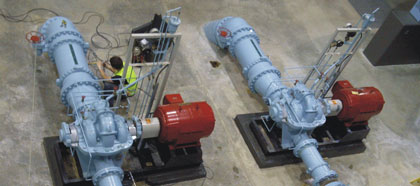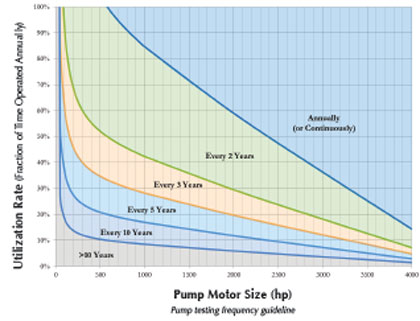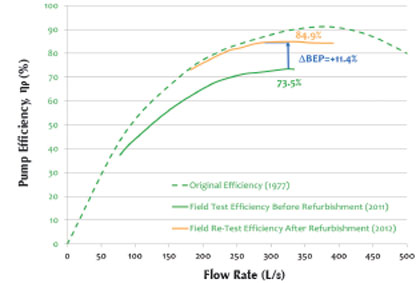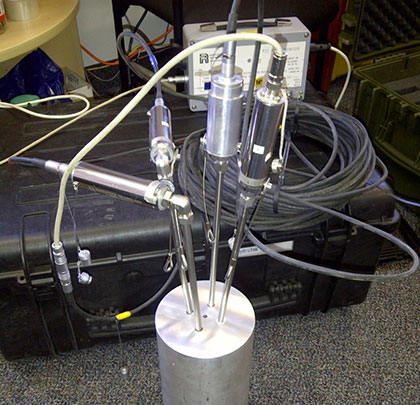A recent large-scale testing program was conducted across Ontario in which the actual performance and efficiency of water pumps was assessed and compared against original manufacturer specifications. The results were interesting and lifted the veil of uncertainty which often surrounds such matters and exposed opportunities where substantial savings in energy efficiency were available.
FIELD TESTING CRITICAL TO UNDERSTANDING PERFORMANCE
The vast majority of tests were conducted using the innovative and highly accurate Thermodynamic Method which measures the thermal energy gain in the pumped water, among other parameters including pressure and power supplied to the pump motor, to compute pump inefficiency directly. This method was found to be highly, although sometimes not universally, applicable relative to its conventional method counterpart which relies heavily on flow measurements which can be difficult to obtain with accuracy in many practical settings.
The results:
- 9.3 percent average reduction between manufacturer’s original peak efficiency and actual peak efficiency; and
- 12.7 percent average reduction between manufacturer’s original peak efficiency and actual efficiency at typical operating point noting that, in practice, pumps often operate outside of their range of peak efficiency.
The average wire-to-water efficiency was found to be 69.4 percent, meaning that more than 30 percent of the input energy is lost due to pump, motor and drive inefficiencies, with the pump inefficiency making up the vast majority of this loss.

Sample pump testing results comparing actual performance to original manufacturer specifications
SAVING MONEY THROUGH OPERATIONAL CHANGES
With accurate and reliable knowledge of the actual performance of pumps, the information is available to support changes in the way existing pumps are operated, including their scheduling, utilization and combinations. This can be a very cost-effective way of reducing energy costs with minimal investment required and, based on the results of the testing, there is ample room to consider such operational improvements with positive effect.

Pump performance and efficiency testing services are readily available and highly informative.
SAVING MONEY THROUGH REFURBISHMENT
Tests conducted before and after pump refurbishments show encouraging results, with the recovery of lost efficiency—measured as the difference between peak manufacturer efficiency and peak field efficiency before refurbishment—commonly in the range of 50 to 70 percent, depending on specific circumstances. Thus, sufficient information is now available to construct credible business cases supporting the refurbishment of pumps.

Pump testing frequency guideline
ESTABLISHING TESTING SCHEDULES
It is quite common for managers to establish routine schedules for asset management activities (e.g., lubricant or bearing replacement, component cleaning, etc.) based on a uniform frequency such as every two years, every five years, etc. When it comes to pump testing for purposes of controlling energy usage, it is sometimes more practical to consider pumps on the basis of their energy consumption, noting that the amount of energy consumed by pumps increases with: (1) the size of the pump and its motor; and (2) its utilization rate. That is, a large pump that is rarely used can easily consume less power than a more modestly sized pump that is used regularly. Testing and potentially refurbishing a pump that is not used sufficiently consumes financial resources without producing the benefit sought (or return on investment).

Sample efficiency recovery from pump refurbishment
To assist managers with this, a graphical guideline for pump test frequency was developed based on economic principles to ensure a positive return on investment. Of course, this is not meant to be interpreted rigidly, and certainly other important factors may cause some pumps to be tested more frequently than the graphic would suggest, such as the criticality of a pump to a system’s performance. One can easily envision a small system supplied by pumps only (i.e., a closed system) which, upon the failure of a pump, may no longer be able to deliver any service.
Numerous other examples easily come to mind as well. In these cases, more routine testing of critical pumps will help to identify early warning signs to avoid such crisis situations. Amongst other useful times to test pumps include immediately upon installation to both verify initial performance relative to design requirements, as well as to establish an in-situ (rather than factory) baseline from which trends can be drawn with results from future tests. ■
About the Author
Fabian Papa and Djordje Radulj are with HydraTek & Associates, a consulting firm specializing in hydraulic and energy investigations of fluid systems. They can be reached at 416.238.7681 or at f.papa@hydratek.com and d.radulj@hydratek.com. For more information on HydraTek’s Ontario-wide pump performance and efficiency testing project, or to request a full copy of the final report, visit www.hydratek.com/opa.
MODERN PUMPING TODAY, December 2014
Did you enjoy this article?
Subscribe to the FREE Digital Edition of Modern Pumping Today Magazine!


